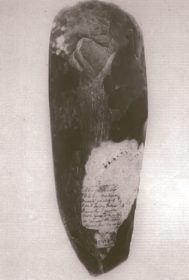Jacques Boucher de Crèvecoeur de Perthes was born September 10,1788, in Rethel, France.
Considered in France as the “father of prehistory,” Boucher de Perthes worked from 1825 as a custom officer in Abbeville, like his father did, until 1853, when he was 65. From then until 1860, he embarked on six big trips to Africa and Europe. His father was also a botanist, so he gave to his son a broad culture on arts and sciences. In 1837, he met Dr. Casimir Picard. Influenced by him, he became fond of archaeology. Picard introduced him to stratigraphical methods and caused his interest in the Somme River Valley.
Boucher de Perthes undertook surveys on Somme River terraces, finding abundant Paleolithic industry. The tools were located on the high terraces. They also were associated with bone remains of extinct animals.
 The findings proved that the antiquity of man was greater than previously proposed by the Catholic Church (4004 years BC). These results were first published in 1847 in Paris, included in the first of the volumes of his Antiquités celtiques antédiluviennes.
The findings proved that the antiquity of man was greater than previously proposed by the Catholic Church (4004 years BC). These results were first published in 1847 in Paris, included in the first of the volumes of his Antiquités celtiques antédiluviennes.
The reactions to such innovative theories came quickly. Part of Boucher de Perthes’s work was dedicated to describing the strange “hieroglyphs” or symbols that he observed on some stones. There is no doubt they were natural, but he found strong opposition from the scientific establishment. One of his first detractors, another “amateur” archaeologist, Jean Paul Rigollot (1810-1873), excavated the Saint-Acheul and Saint-Roch deposits, in his intention of refuting Boucher de Perthes’s theories. To his surprise, he found new materials to reassert the new hypothesis. At the same time, other geologists obtained data that confirmed his thesis. Among them stood out the geologist Charles Lyell (1797-1875), the palaeontologist and botanist Hugh Falconer (1808-1865), and the archaeologist and geologist John Evans (1823-1908), who also visited Saint-Acheul by 1859. Finally, the great palaeontologist Edouard Lartet (1801-1871) published in 1861 his own work from Aurignac Cave. The deposits were so well preserved that there was no doubt of their antiquity, and the presence of man was undoubtedly linked with extinct animals.
During his life, Boucher wrote 49 books. Among them, his memoirs were published in eight volumes. Boucher de Perthes died on August 5, 1868, in Abbeville, France. His great intuition laid the foundation of the modern prehistory.
The Museum Boucher de Perthes can be visited today in the village of Abbeville, opened in 1954. The collections cover diverse materials and chronological periods.
References:
- Aufrère, L. (1940). Figures de préhistoriens: Boucher de Perthes. Paris: Leroux Presses Universitaires.
- Boucher de Perthes, J. (1847). Antiquités celtiques antédiluviennes. Mémoire sur l’industrie primitive et les arts à leur origine. Paris: Treutel et Wurtz.
- Cohen, C., & Hublin, J.-J. (1989). Boucher de Perthes: Les origines romantiques de la préhistoire. Paris: Belin.

